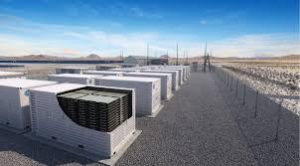
Near Dallas, Texas, work has started on a large Lily solar storage project that is considered to be the first hybrid energy project in North America integrating a renewable energy plant with utility-scale battery storage.
Enel Green Power, the company with wind farm operations in Oklahoma is behind the project that pairs the two technologies. With it, Enel can store energy generated by the renewable plants to be delivered when needed and to help smooth the supply of electricity to the grid or during periods of high electricity demand.
In addition to the Lily solar + storage project, Enel plans to install approximately 1 GW of battery storage capacity across its new and existing wind and solar projects in the United States over the next two years according to a report in Solar Polar World.
Located southeast of Dallas in Kaufman County, Texas, the Lily solar + storage project comprises a 146 MWac PV facility paired with a 50 MWac battery and is expected to be operational by Summer 2021.
“This substantial commitment to deploy battery storage capacity underscores Enel’s leadership in constructing innovative hybrid projects that will drive the ongoing decarbonization of the power sector in the United States and around the world,” said Antonio Cammisecra, CEO of Enel Green Power. “The Lily solar + storage project highlights the huge potential of renewable energy growth and represents the future of power generation, which will increasingly be made up by sustainable, flexible plants that provide zero-carbon electricity while boosting grid stability.”

Lily’s 421,400 PV bifacial panels are expected to generate over 367 GWh each year, which will be delivered to the grid and will charge the co-located battery, equivalent to avoiding the annual emission of over 242,000 tons of CO2 into the atmosphere. The battery storage system is capable of storing up to 75 MWh at a time to be dispatched when solar power generation is low, while also providing the grid access to a clean supply of electricity during periods of high demand.
The Lily solar project was initiated and developed by Red River Renewable Energy, a joint venture among affiliates of Sun Chase Power and MAP Energy.
The construction process for Lily is following Enel Green Power’s “Sustainable Construction Site model,” a collection of practices aimed at minimizing the impact of plant construction on the environment. Enel is exploring a multi-purpose land-use model at the Lily site focused on mutually beneficial agricultural practices in concert with bifacial solar development and operations.
In particular, the company plans to test growing crops under the panels as well as cultivate groundcover plants that support pollinators for the benefit of nearby farmland. The company has previously implemented a similar initiative at the Aurora solar project in Minnesota through a partnership with the National Renewable Energy Laboratory, focused on pollinator-friendly plants and grasses.
Enel Green Power is pursuing an active growth strategy in the U.S. and Canada with the planned installation of around 1 GW of new utility-scale wind and solar projects each year through 2022. For each renewable project in development, Enel Green Power evaluates the opportunity for paired storage to further monetize the energy production of the renewable plant, while providing additional benefits such as supporting grid reliability.
Enel Green Power, and the Enel Group as a whole, is following the status of the COVID-19 pandemic and is responding to protect the health of its workers, employees and the community where it operates. In North America, the company has enacted strict travel guidelines, stepped up office and project site sanitation and implemented ways for colleagues to conduct their work remotely and follow safe working practices if and when on-site.
At the Lily construction site, crews are implementing safe working practices and operations have been structured to maintain social distancing as well as other best practices. The company developed initiatives to support community hospitals, schools and emergency responders in Texas.
Source: Solar Power World





